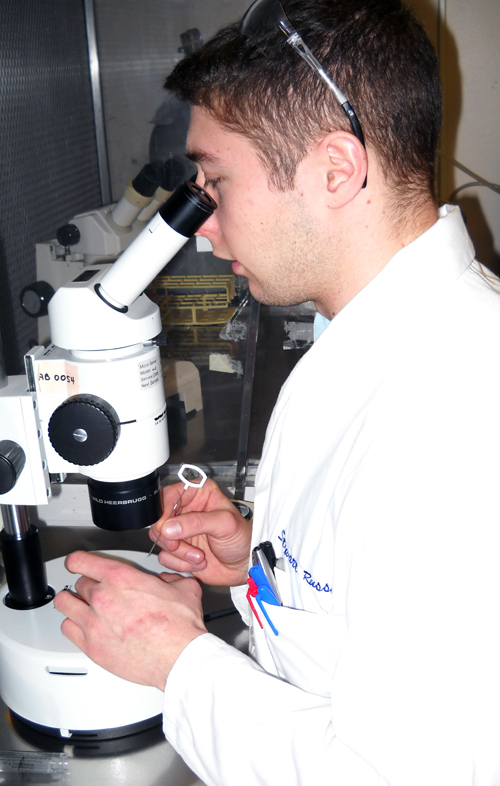
It’s a long-standing question and one that fascinates Stewart Russell: “How do we go from a single cell to a multi-quadrillion-celled organism?”
Learning more about early embryonic development will help satisfy some curiosity for Russell, a PhD student in biomedical science. Along the way, he expects his studies of cattle genetics and molecular biology will also help breeders and producers in Canada’s multitrillion-dollar dairy and beef industries.
Only about one out of three cattle embryos now grows beyond a blastocyst, or the stage of development consisting of a few hundred cells reached within less than a week of fertilization. Improving the odds might start with learning more about the basics.
“There are so many molecular aspects we don’t understand,” says Russell, who works with Prof. Jonathan LaMarre. They belong to the reproductive biology and development research group within the department, occupying a suite of labs in the Ontario Veterinary College.
They’re studying a molecular pathway needed for development of viable embryos. Much of their work is pioneering, says Russell. “My project is one of the only demonstrations that this path is important in early embryogenesis.”
Having shown the presence of the pathway, he now aims to learn how it works. To do that, he will block that pathway and look at resultant problems expected to develop in the embryo.
Researchers know that the pathway is also important in the development of sperm and eggs. They believe it helps protect the genome when DNA is reprogrammed with each new generation.
An animal’s DNA is normally under tight regulation to preserve genetic integrity. But during this reprogramming period, it’s more vulnerable to detrimental elements, says Russell.
Learning what molecular traits make a viable embryo might allow breeders and producers to better select and manipulate material, especially if this research can identify markers for robust embryo development.
Because the industry relies heavily on artificial insemination, Russell benefits from well-known protocols for in vitro fertilization (IVF) in cattle. He works at the lab bench, not directly with animals.
LaMarre says this research is central to the lab’s efforts to learn about pathways controlling fertility and development. “It provides a very strong link between cutting-edge basic biology and the specific needs of agricultural stakeholders to improve productivity.”
Russell started studying plant genetics for his undergrad at Wilfrid Laurier University. “Plants are interesting, but they don’t capture me as much as mammals.”
He’s intrigued by the genetic blueprint – how it contains all the information needed for life, how individuals contain the same blueprint but have different annotations that make them “individuals.”
Looking for a graduate program, Russell found what he calls the most well-established IVF lab in the province in U of G’s Department of Biomedical Sciences.
Originally from St. Thomas, Ont., he joined the Canadian army reserves seven years ago as a co-op high school student. He’s now a corporal with the military engineers – what he calls an “exciting job” in the army.
“Engineers provide mobility and deny it to the enemy,” he says. That means they might install bridges to permit troop movement or disable structures to hinder transportation.
Russell helped provide security during the G8 summit in Huntsville, Ont., in 2010. Based in Waterloo, Ont., he trains mostly at the Canadian Forces School of Military Engineering in New Brunswick.